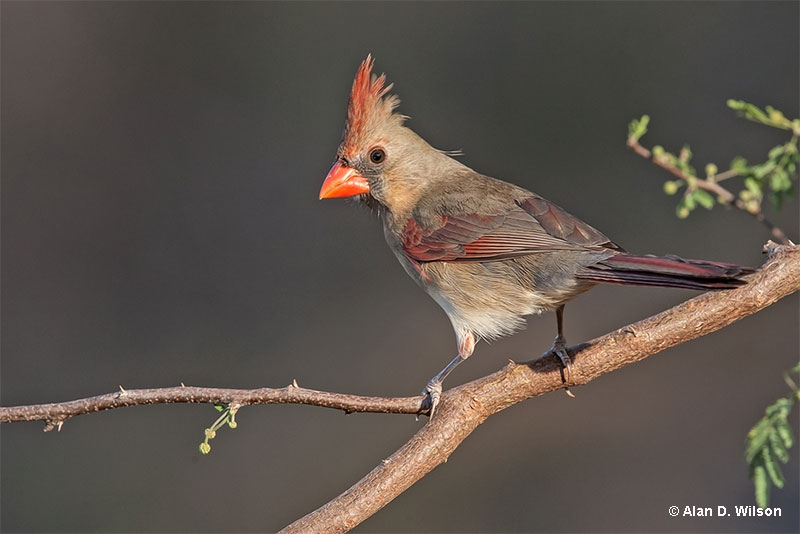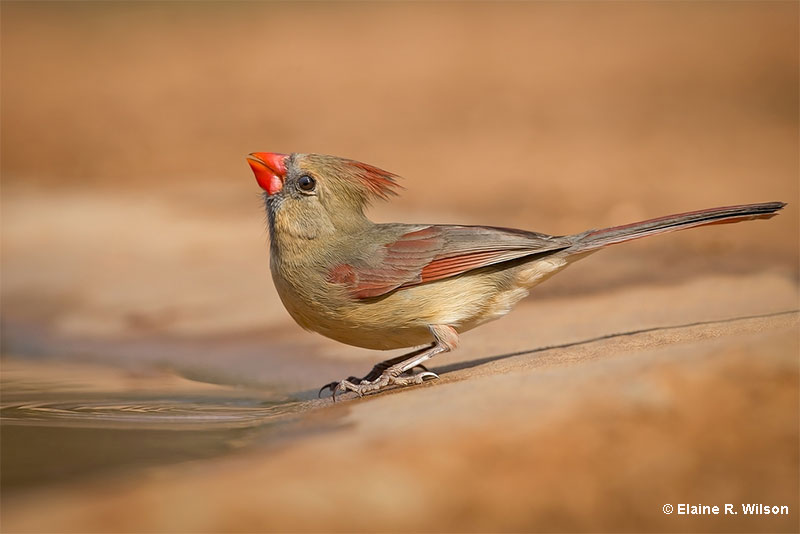
Female cardinals lack the eye-catching, bright crimson of their male counterparts, but they make up for it with red highlights on subtle shades of brown and gray.
Known as “hens”, female cardinals catch our attention with sharp calls, colorful red bills, and a cheerful whistled song.
Spending time on the nest is why female cardinals are much duller than males. Unlike male birds that need to attract females and defend a territory, female cardinals are tasked with building a nest and successfully incubating the eggs until they hatch.
On this page
Female vs Male Cardinal
Male and female Northern Cardinals have the same shape and bill color but differ in other, more obvious ways. In fact, the plumages of male and female cardinals are so different, it doesn’t take more than a glimpse to tell them apart.
No matter the season, male Northern Cardinals are bright red with black on the face and throat, and females are a pleasant shade of brown with some gray, and bits of dull red on the crest, wings, and tail.
Female cardinals also have duller black on the throat and face than the contrasting jet black shown by male birds.

Male Northern Cardinals are known for their bright-red plumage.
On a more subtle note, male Northern Cardinals are slightly bigger than females. However, this difference is so small, it can be pretty hard to notice when seeing a cardinal sing from the top of a bush or feasting on seeds at a backyard feeder.
Related: Do you know what cardinals symbolize?
This tiny difference in size also holds true for the other species of cardinal in the USA, the Pyrrhuloxia, and is probably also true for the lesser-known Vermillion Cardinal of arid habitats in northern Colombia and Venezuela.
Like the familiar Northern Cardinal, the females of these other species also have the same bill color and shape as male birds but are plumaged in plain shades of gray, buff, and brown with a few red highlights in the crest, wings, and tail.
Northern Cardinal happens to be a state bird for seven states: Illinois, Indiana, Kentucky, North Carolina, Ohio, Virginia and West Virginia.
Scientific information
These are some comparisons between male and female Northern Cardinals.
| Males | Females | |
| Size | Slightly larger, 8.6 – 9 inches in length. Their weight averages 45 grams. | Slightly smaller and with a lot of overlap, 8.2 – 8.5 inches in length. Their weight averages 43 grams. |
| Plumage | Males are mostly bright red with jet black on the throat and face, and dull red on the back, wings, and tail. | Females are grayish brown and buff with blackish-gray on the face and throat, and have red restricted to the crest, wings, and tail. |
| Behaviors | Males help pick a nesting site and bring food to the nesting female and young birds. | Females also pick the nesting site, build the nest, incubate the eggs, brood the young, and help feed them. |
| Sounds | Male cardinals sing much more often than females. | Female cardinals make the same calls as males and sing the same type of song but don’t sing nearly as often. |
| Life Expectancy | The average life of a male cardinal is probably 3 years although the oldest male recorded was 13 years old. | The average life of a female cardinal is probably 3 years but they may live a bit longer than males. The longest living female cardinal was 15 years old. |
Plumage
In terms of plumage, male and female Northern Cardinals have radical differences. While male birds are mostly bright red with jet black on the face and throat, females are a blend of gray, buff, and brown with an orange bill, and bits of red in the crest, wings, and tail.

Female cardinals are much duller when it comes to plumage.
On snowy days in particular, the male Northern Cardinal stands out like an eye-catching, red stoplight while the female makes much less of an exclamation against a background of brown bare tree trunks and woodpiles.
The differences between male and female Pyrrhuloxias aren’t as severe, but it’s still easy to tell them apart.
Male Pyrrhuloxias are an easy gray tinted with raspberry on the crest, front of the bird, wings, and tail, while the female Pyrrhuloxia is a more subtle, pale grayish-brown with some dark markings on the face and throat, and hints of red in the crest, wings, and tail.
Behavior

Female Northern Cardinal
In most ways, male and female cardinals act similarly. They forage the same way, both defend territories against other cardinals (males against males and females against females), and both sexes even sing.
However, female cardinals don’t sing as much as males and do most of the nest-building, incubation, and brooding of baby cardinals.
How To Tell A Younger Cardinal’s Gender?
Telling adult male from female cardinals is pretty easy, but not when they are very young. However, by fall, male and female cardinals begin to acquire adult feathers and can be easily told apart.
If the young cardinal has red feathers on the head (except for the crest), back, or front of the bird, it is a male. If the bird has brown feathers in those same places, it is a female cardinal.
Although the gender of young Northern Cardinals before their first molt is impossible to know, the crest and deep, conical bill still make it easy to identify them as cardinals.
Lifecycle
When cardinals hatch, the naked and helpless babies are fed by their mother and grow quickly. By the time they are ten days old, young cardinals have feathers and leave the nest but stay near it for three weeks more. During this time, they still depend on their parents for food.
After 8 days, they fly well enough to escape predators and are fed on occasion by the adults until they can fend for themselves, eight weeks after leaving the nest. Young cardinals form flocks until they mature and establish territories on the first spring after hatching.
Cardinals have two to four broods each summer but raise few young. Studies have shown that less than 40% of nests are successful because many are destroyed by predators or parasitized by Brown-headed Cowbirds.
Related: Do cardinals mate for life?
Adult cardinals usually live for two or three years, although a few birds live much longer.
Frequently Asked Questions
What color is a female cardinal?
A female cardinal is a blend of subtle gray, brown, and buff with red highlights in the crest, wings, and tail. Like the male cardinal, she also has an orange bill.
How rare is it to see a female cardinal?
It is not rare to see female cardinals. They might not be as obvious as male cardinals but are just as common.
Do female cardinals turn red?
No. Female cardinals only have red on the crest, wings, and tail.
Are female cardinals aggressive?
Yes, but only in certain situations. Female cardinals are not overly aggressive but can fight with other females to defend their territories, and fight with other birds over food.
Conclusions
The female cardinal might not be as obvious as the vermillion-colored male, but she is just as common and shows beauty in more subtle ways. She has red on the crest, wings, and tail, and sings the same song as the male, although not nearly as often.
Female cardinals take care of most nesting duties, visit feeders just as much as males, and are common garden birds in the eastern and southern USA and Mexico.

